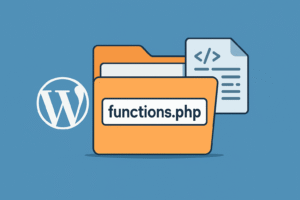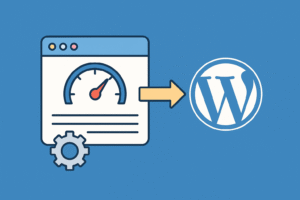If you’ve ever followed a WordPress tutorial or installed custom code, you’ve likely encountered the file called functions.php. But what exactly is it, and how should you use it safely?
In this beginner-friendly guide, we’ll explain what functions.php does, how it works inside a theme, and how to add custom functions without breaking your site.
🔍 What Is functions.php in WordPress?
The functions.php file — also known as the theme functions file — is a special file within every WordPress theme.
It allows you to:
- Add custom code snippets
- Enable or disable theme features
- Register widgets, menus, and image sizes
- Hook into WordPress actions and filters
It behaves similarly to a WordPress plugin, but is specific to the active theme.
📂 Where Is functions.php Located?
You can find it in:
/wp-content/themes/your-theme-name/functions.phpYou can access it via:
- WordPress Dashboard → Appearance → Theme File Editor
- FTP or hosting File Manager
🛠️ What Can You Do with functions.php?
Here are some popular examples:
✅ Disable Gutenberg Editor
add_filter('use_block_editor_for_post', '__return_false');✅ Add Custom Image Sizes
add_image_size('custom-thumb', 600, 400, true);✅ Enable Featured Images
add_theme_support('post-thumbnails');✅ Enqueue Custom Styles or Scripts
function solvewp_enqueue_styles() {
wp_enqueue_style('theme-style', get_stylesheet_uri());
}
add_action('wp_enqueue_scripts', 'solvewp_enqueue_styles');🧠 functions.php vs Plugin: What’s the Difference?
| Feature | functions.php | Plugin |
|---|---|---|
| Scope | Active theme only | Active site-wide |
| Portability | Breaks if you change themes | Works across themes |
| Ideal for | Theme-related functionality | Site-wide features or tools |
| Update-safe? | ❌ Risky without a child theme | ✅ Safe with proper coding |
If the function you’re adding is unrelated to your theme’s layout or design, use a plugin instead.
⚠️ Dangers of Editing functions.php (And How to Stay Safe)
🚨 Common Mistakes:
- Copy-pasting code with syntax errors
- Editing on a live site without testing
- Not using a child theme (gets overwritten during updates)
✅ Safe Practices:
- Always test on a staging or local site first
- Use a child theme to preserve changes
- Use a plugin like Code Snippets to manage small pieces of code safely
🧒 Beginner Tips Before You Touch functions.php
- Back up your site first using plugins like UpdraftPlus
- Wrap custom functions in
function_exists()to avoid conflicts
if ( !function_exists('custom_function_name') ) {
function custom_function_name() {
// your code
}
}- Add only one new function at a time and test
- Use proper indentation and avoid unnecessary closing PHP tags
🔗 Internal Related Articles (on SolveWP.in)
- How to Install a WordPress Plugin
- How to Speed Up WordPress Website
- Optimizing CSS and JS in WordPress
🌐 External Reference Links
✅ Final Thoughts
The functions.php file is powerful — but with great power comes great responsibility. It gives you the ability to extend your site’s features quickly, but editing it carelessly can lead to critical errors or white screens.
Use
functions.phpfor small, theme-specific changes, but always with caution.
For everything else, especially if it needs to persist across theme changes, consider creating a simple plugin or using Code Snippets.
Want to explore more? Check out other WordPress development tips and tutorials at SolveWP.in!




